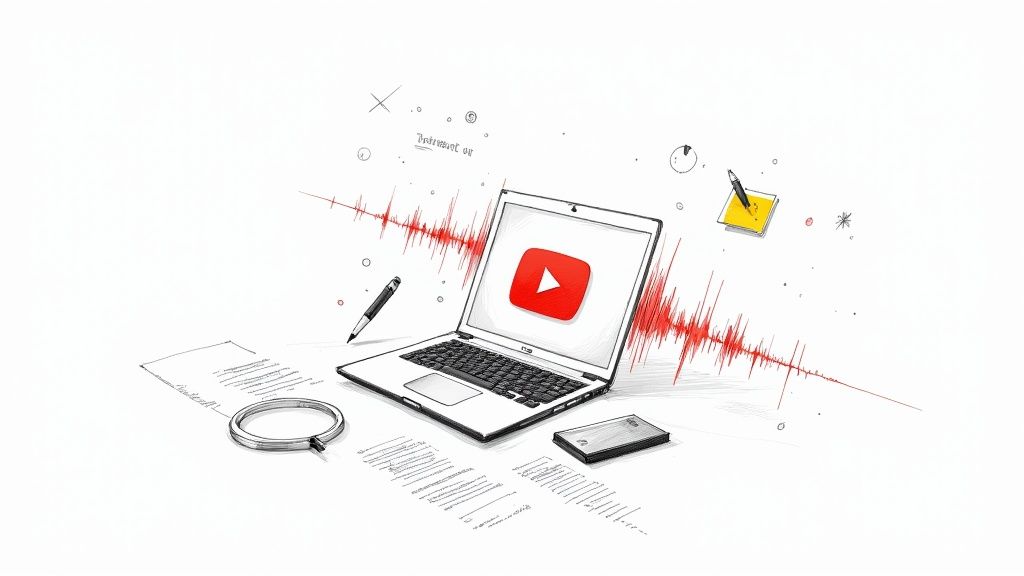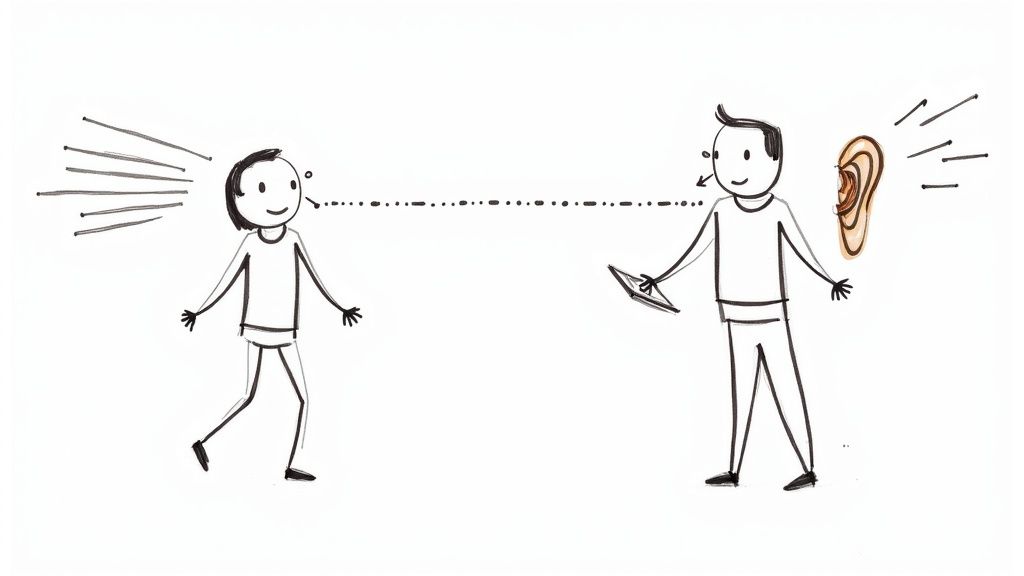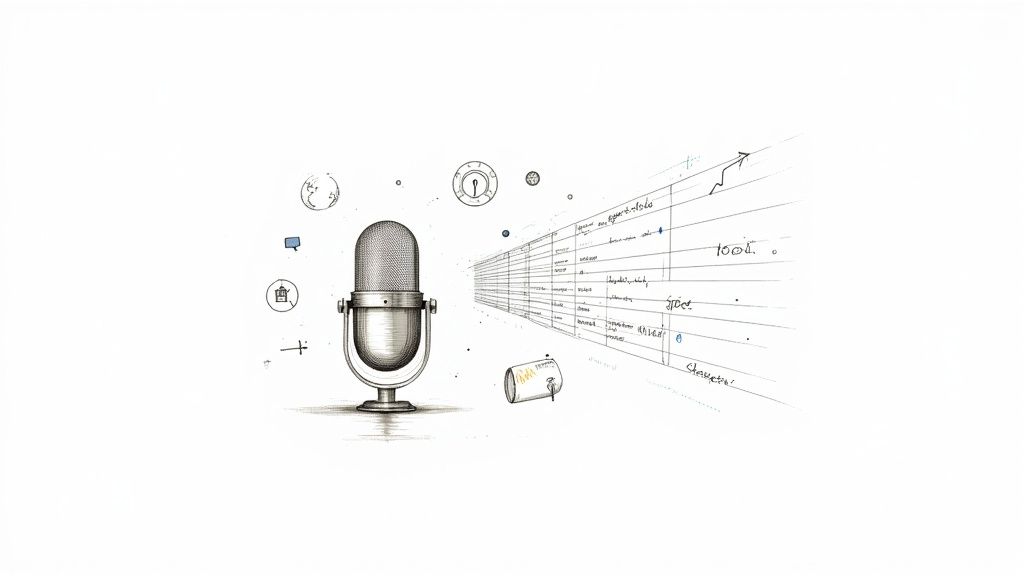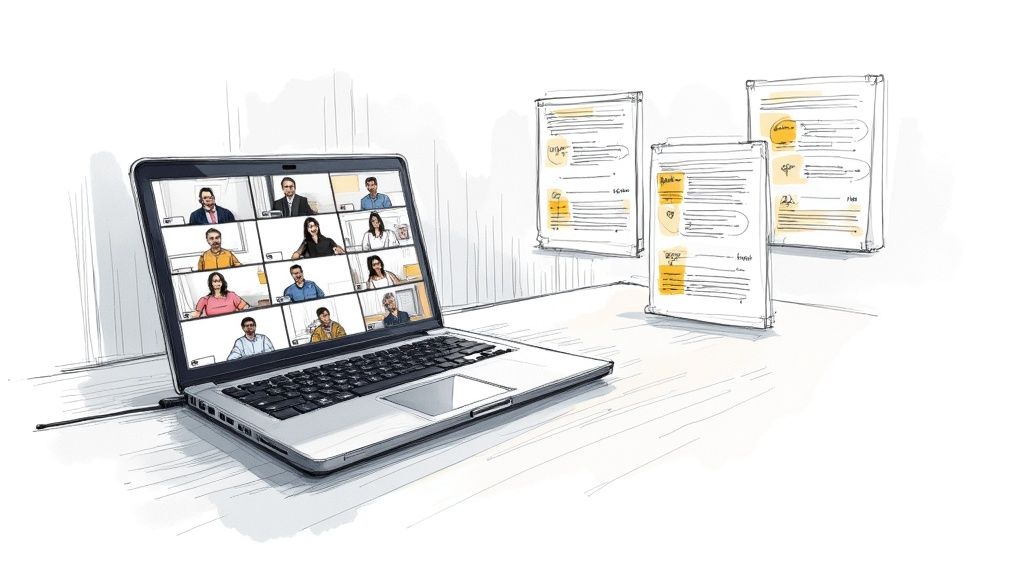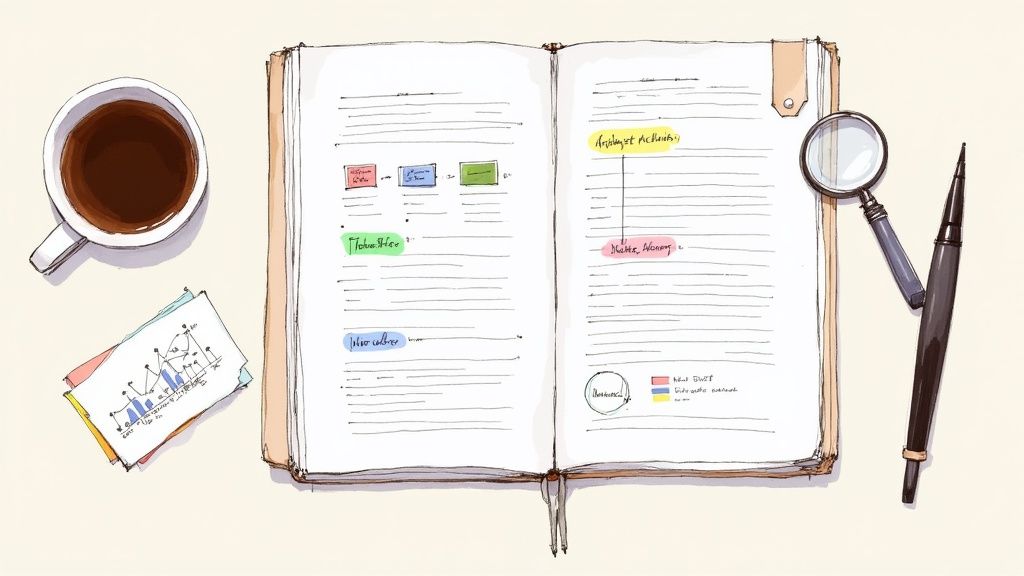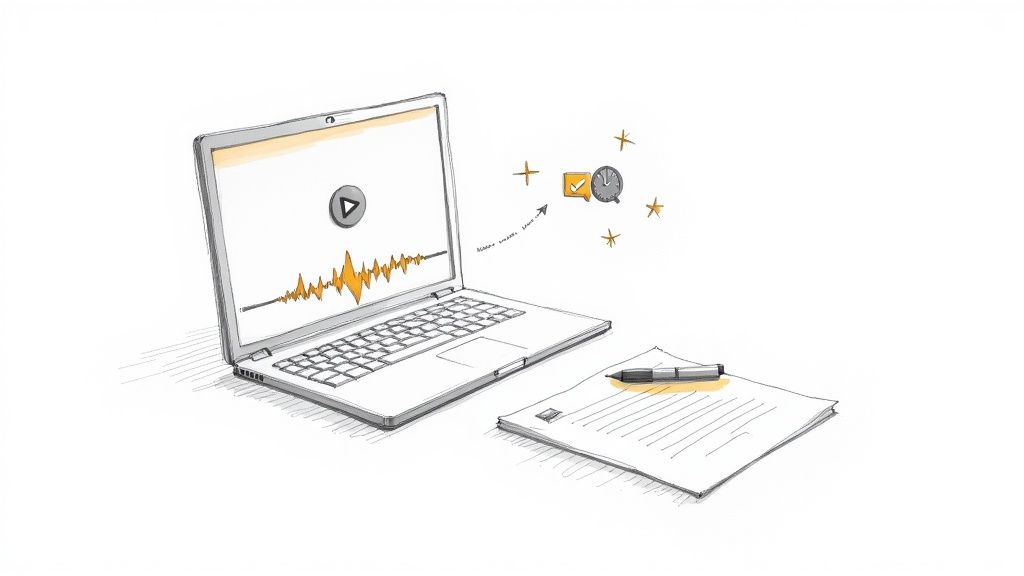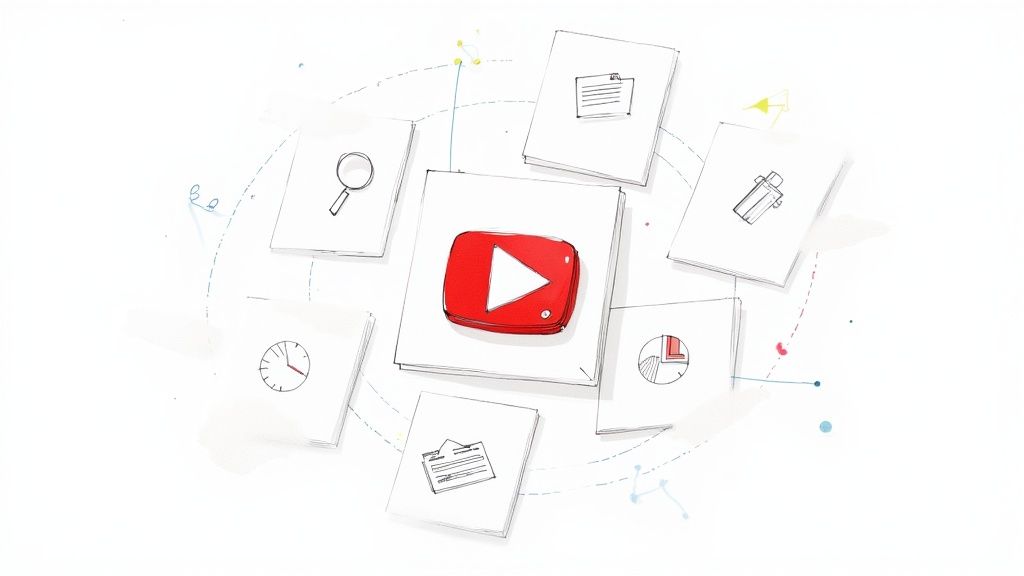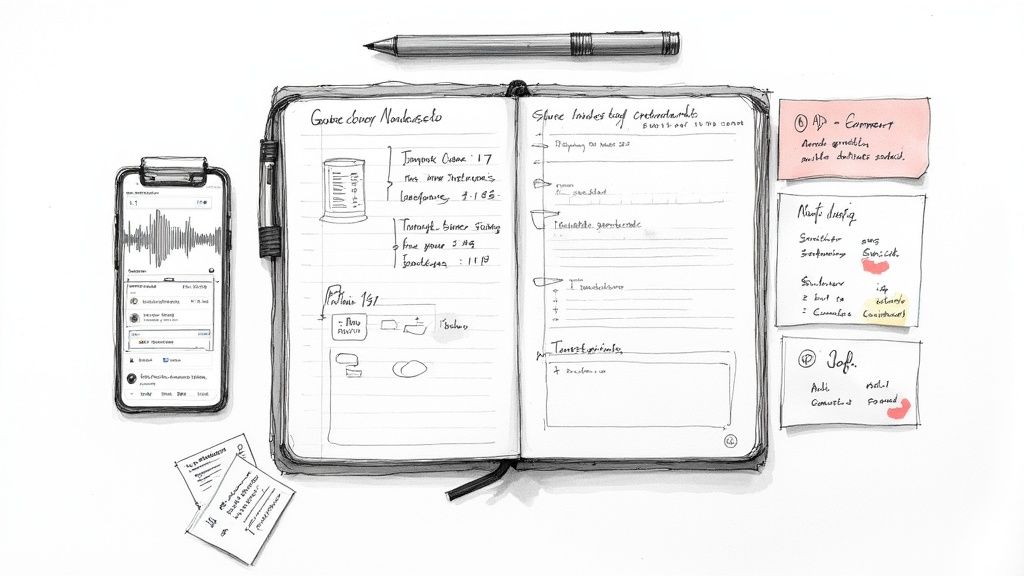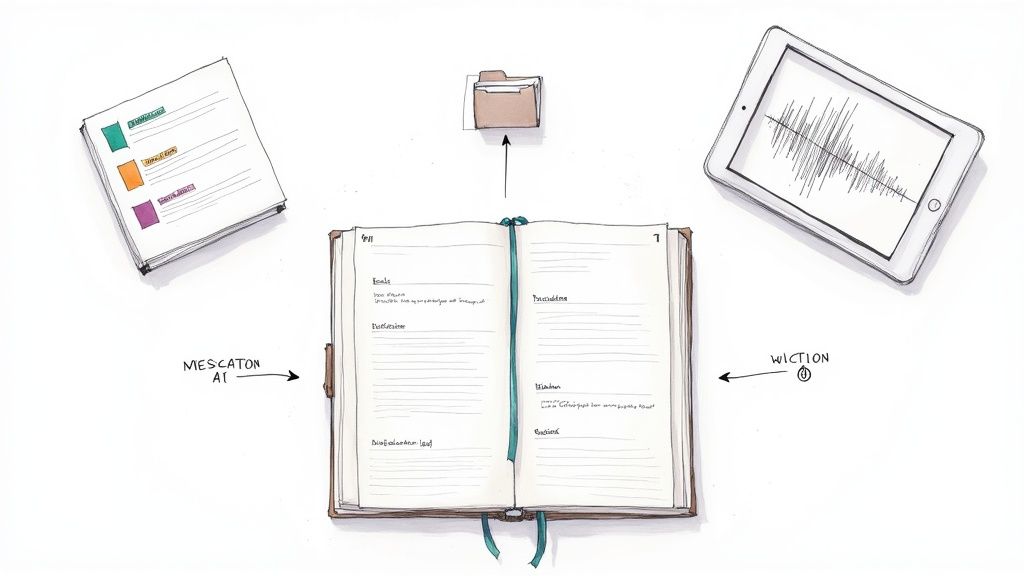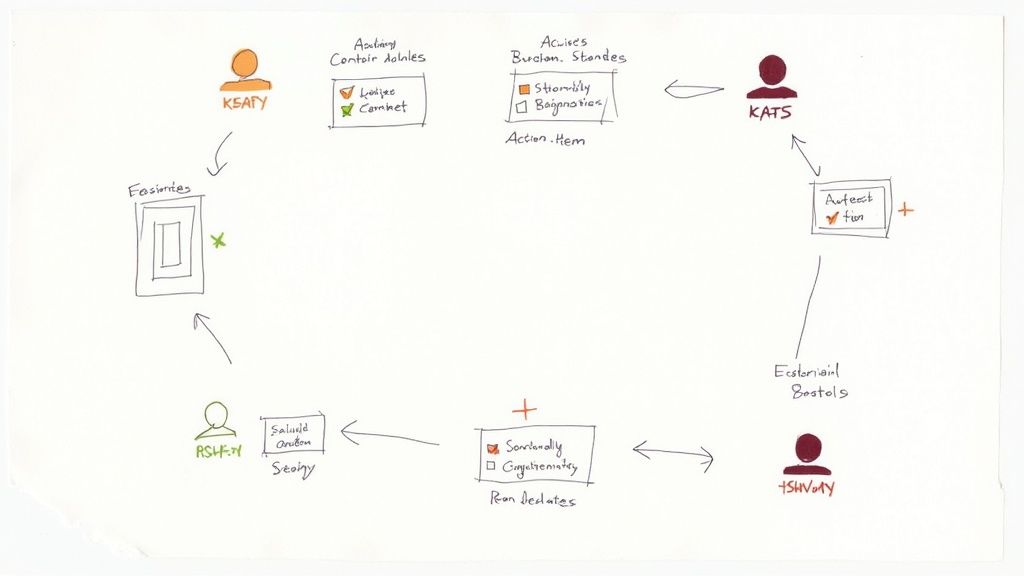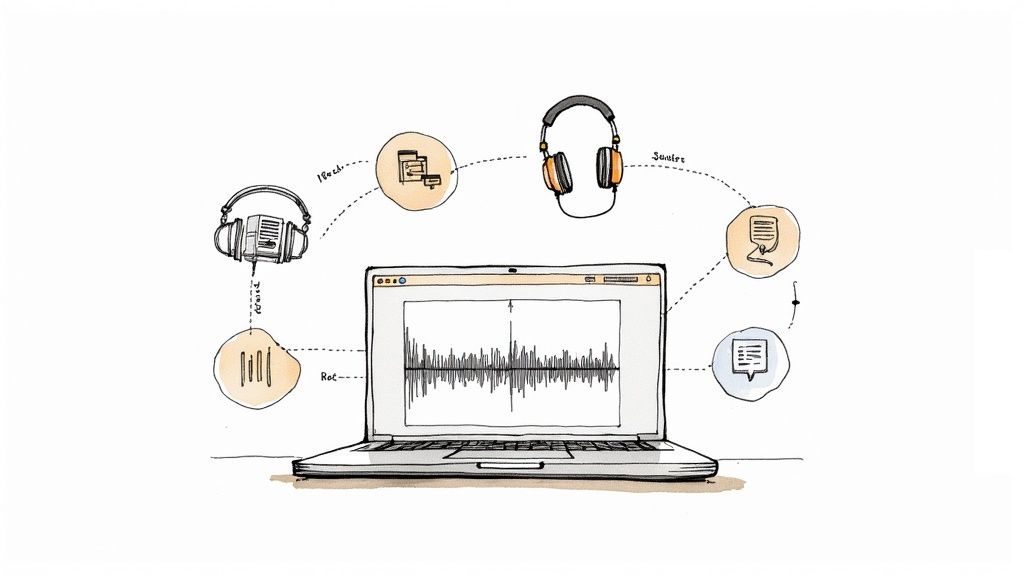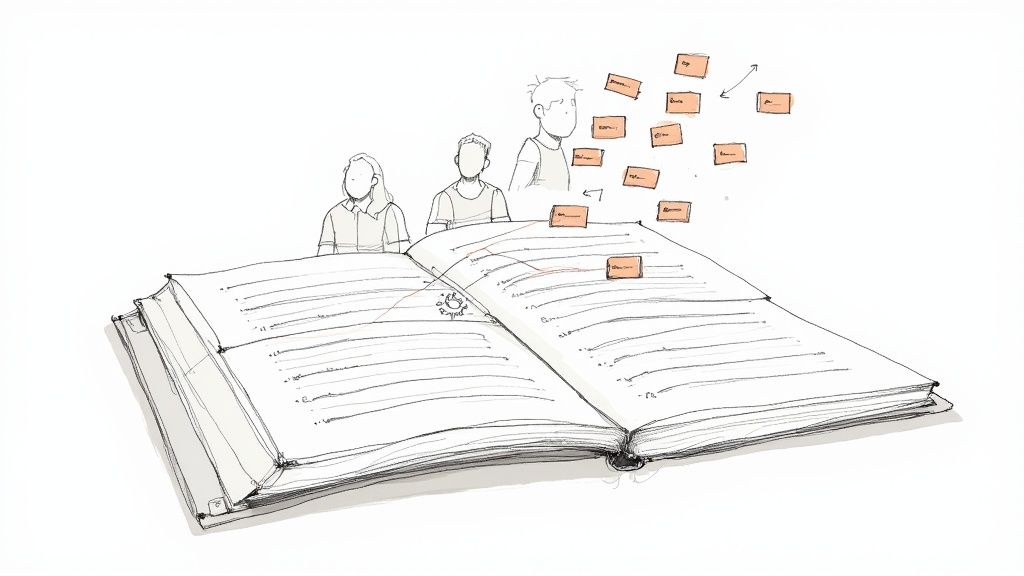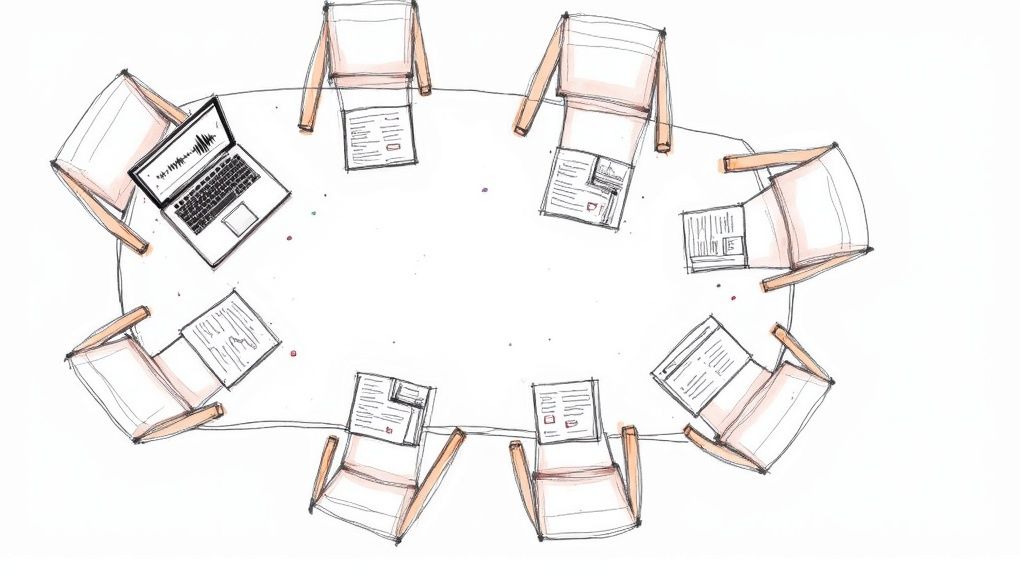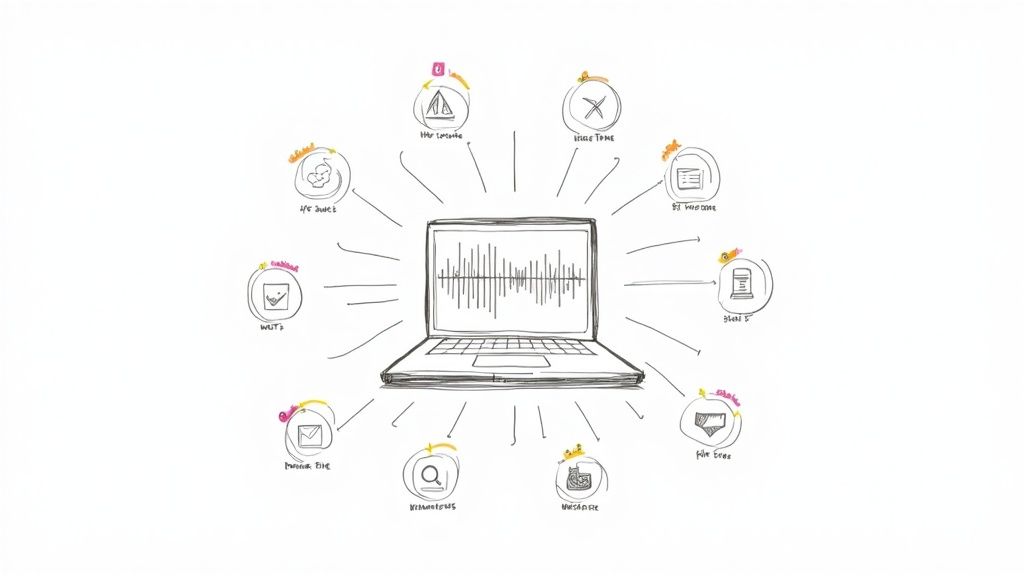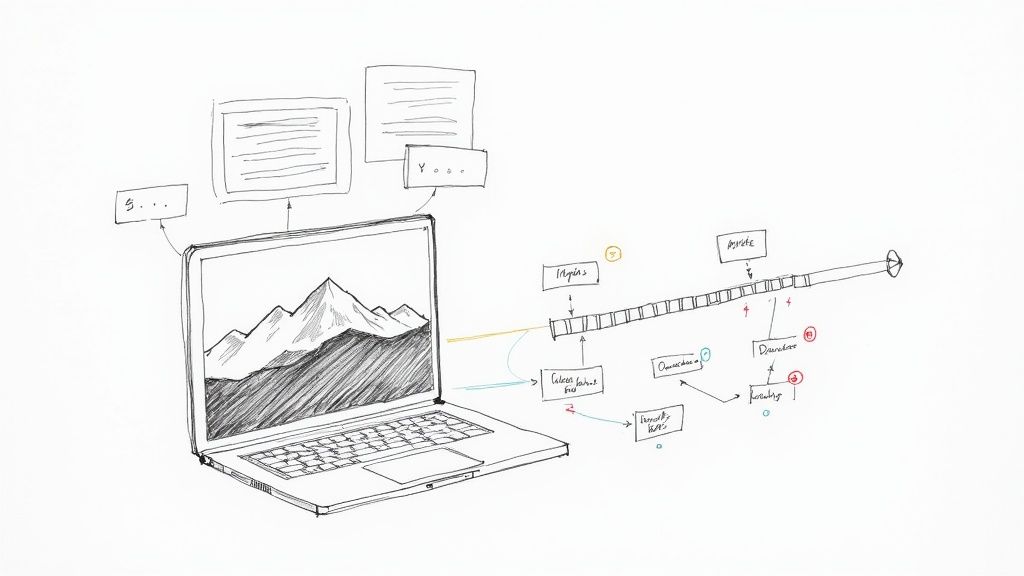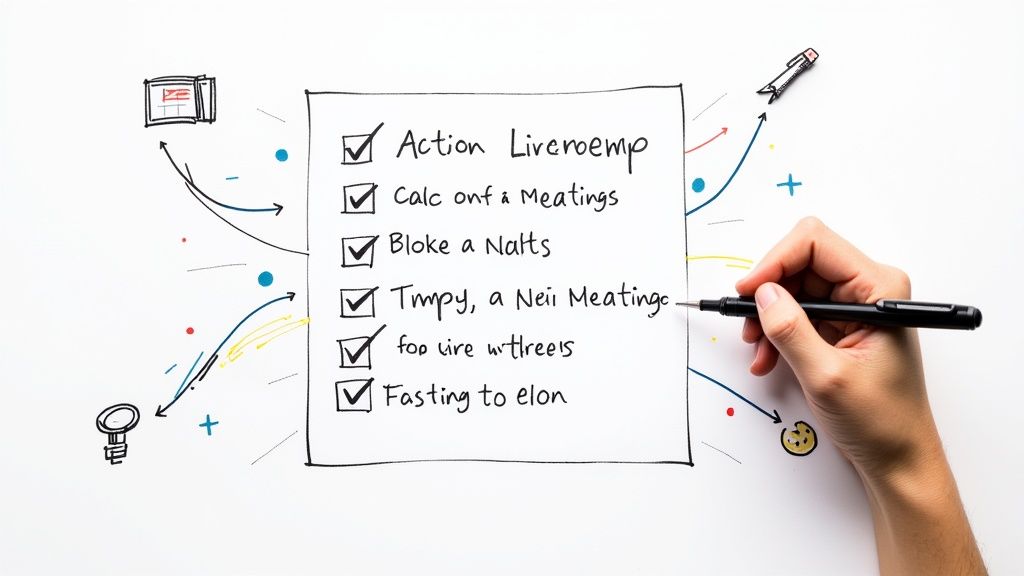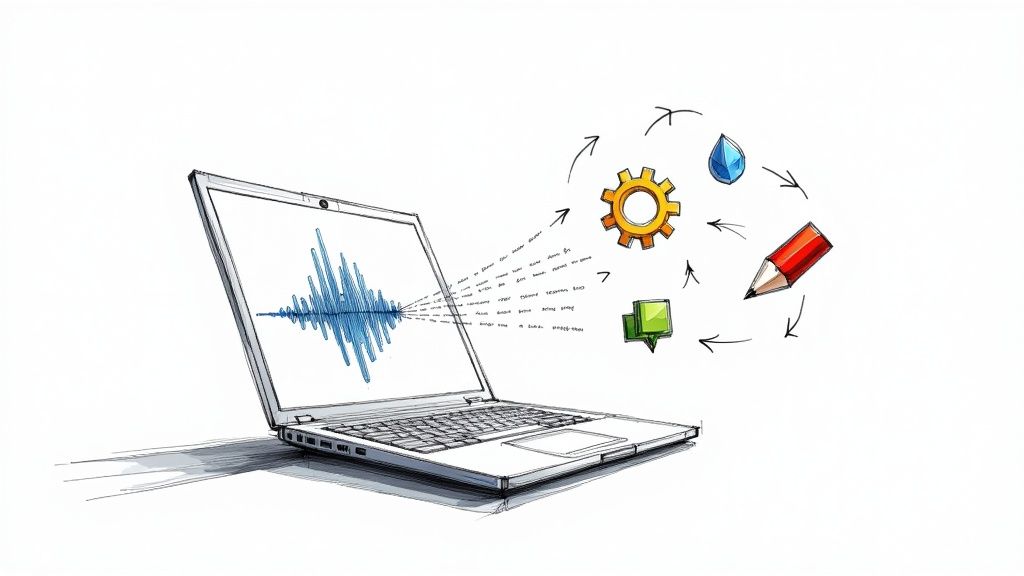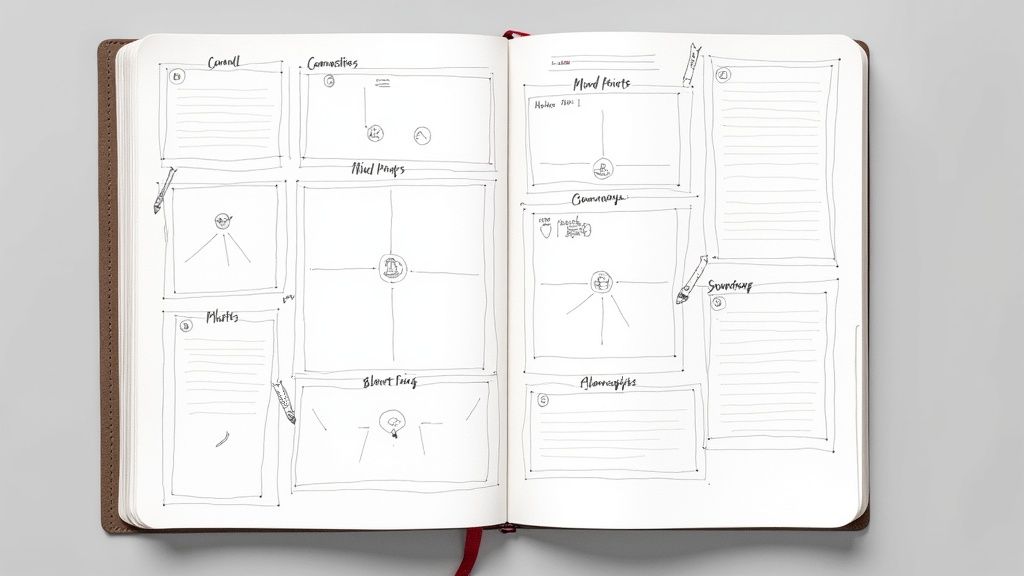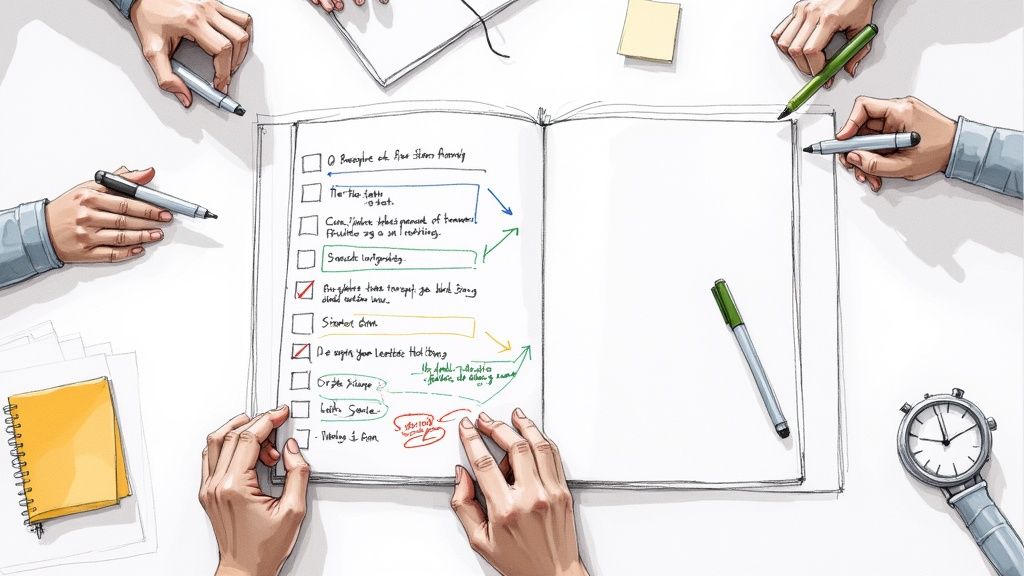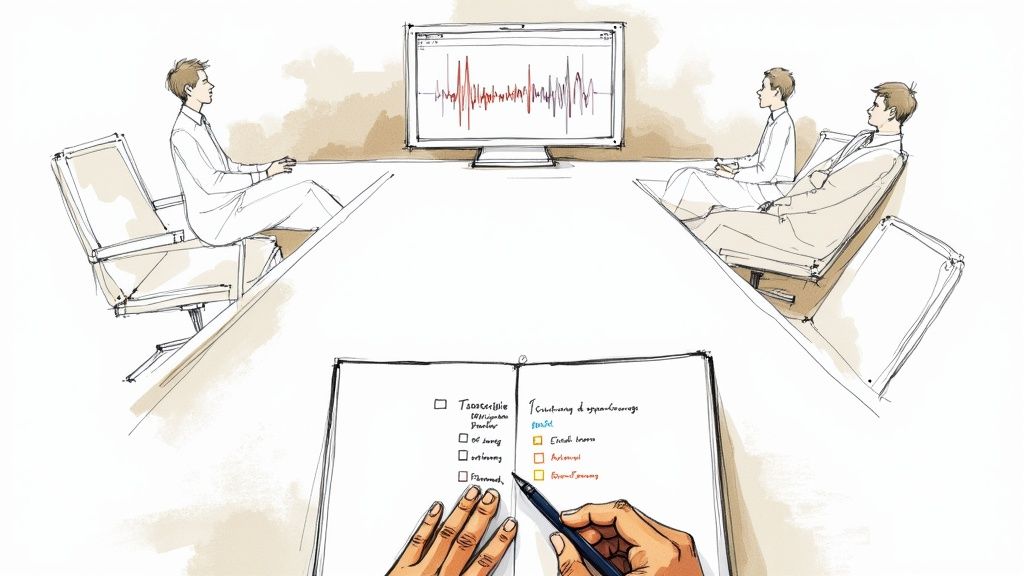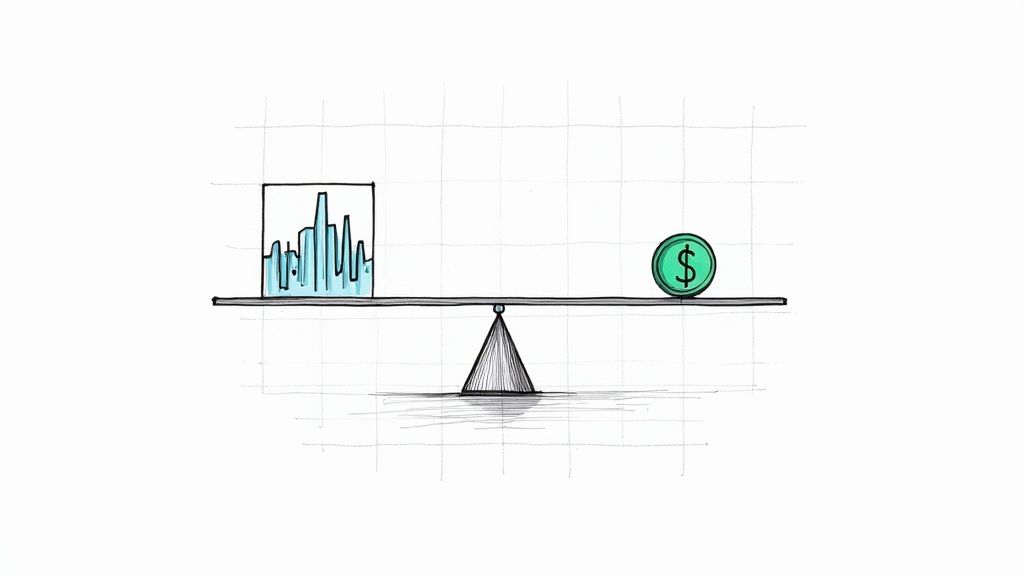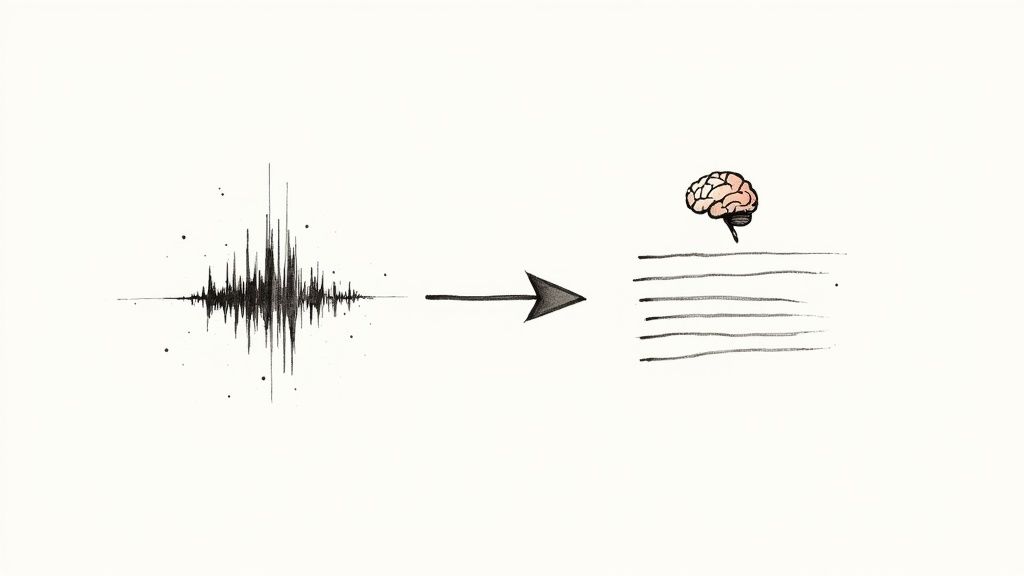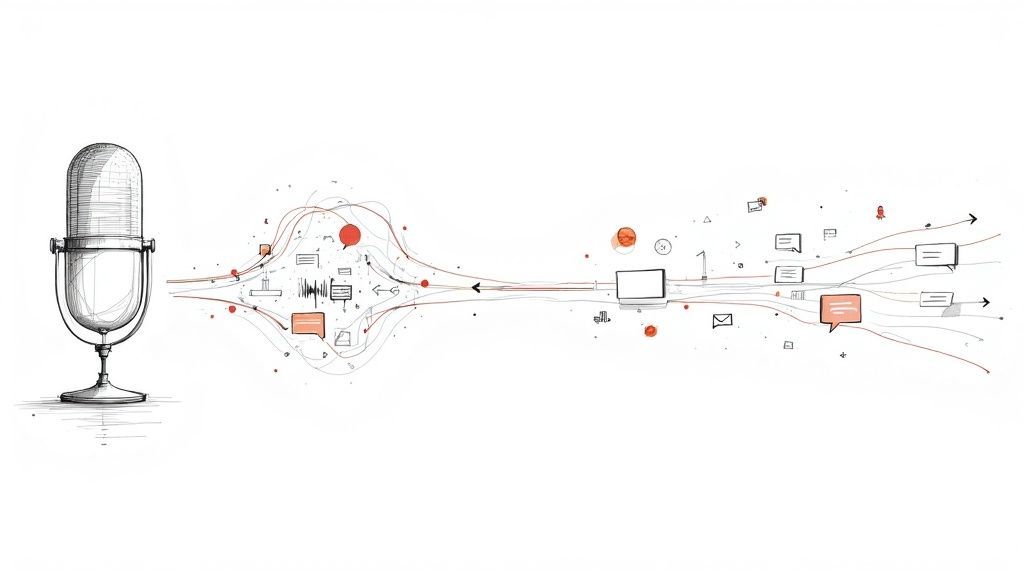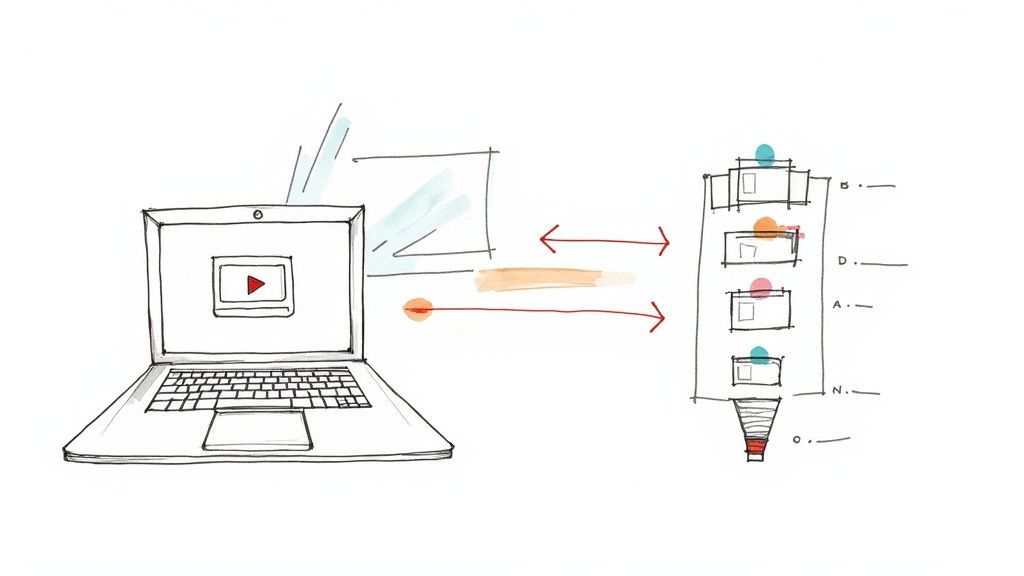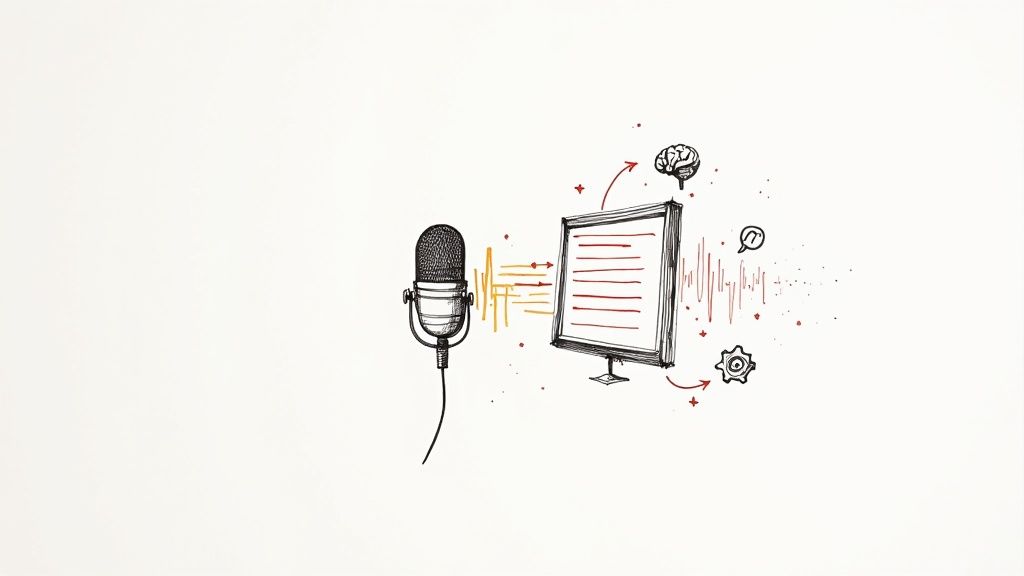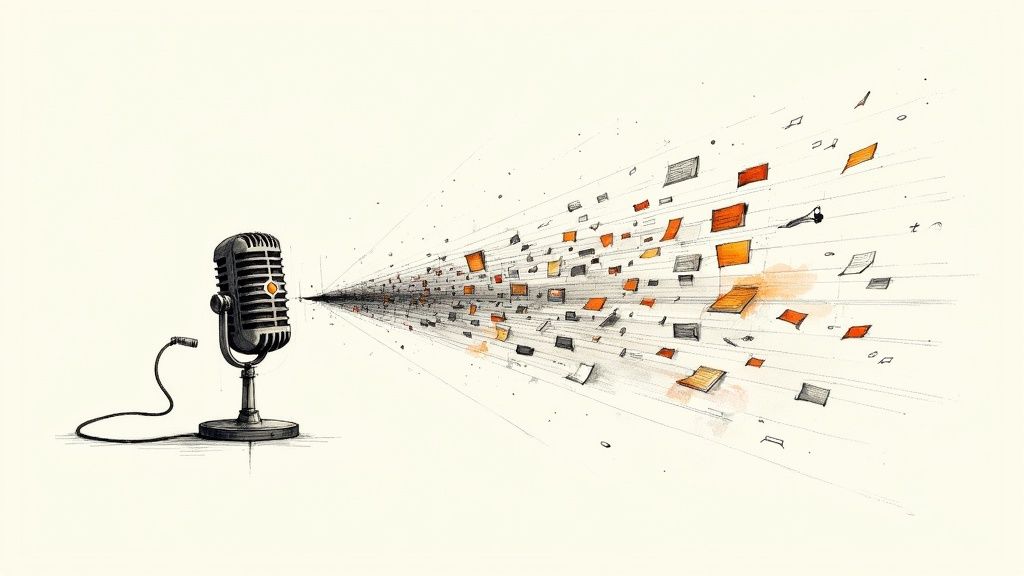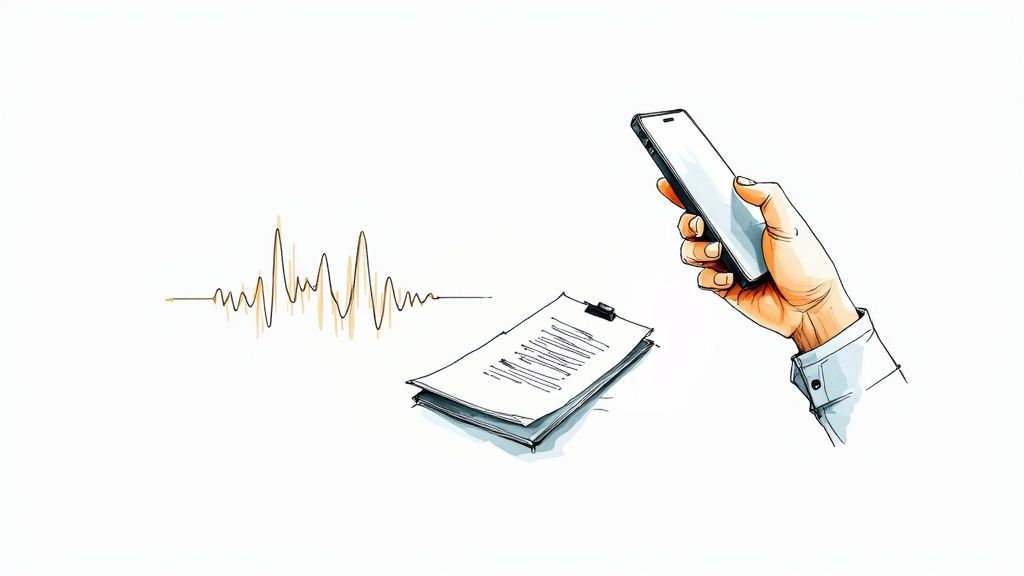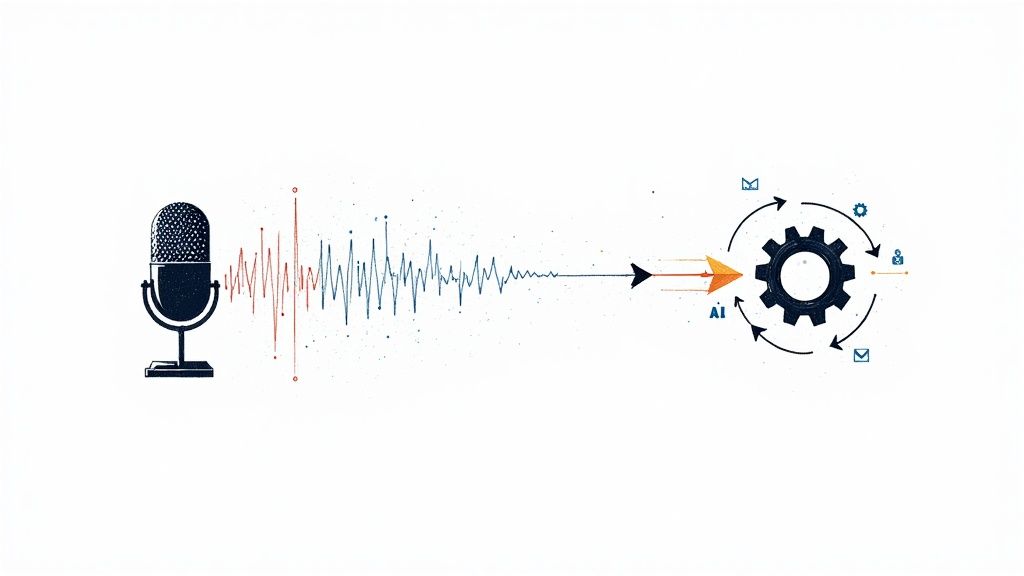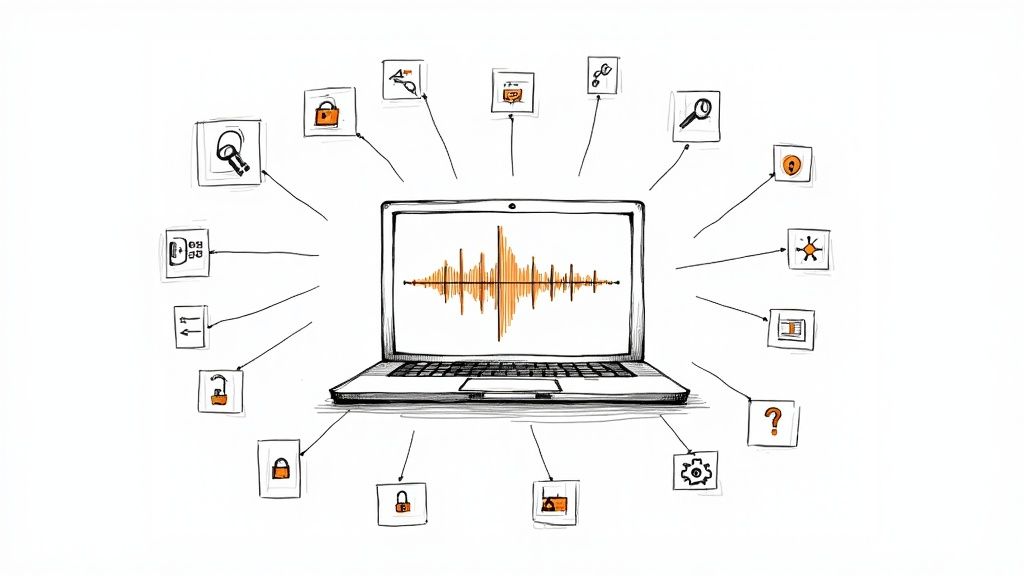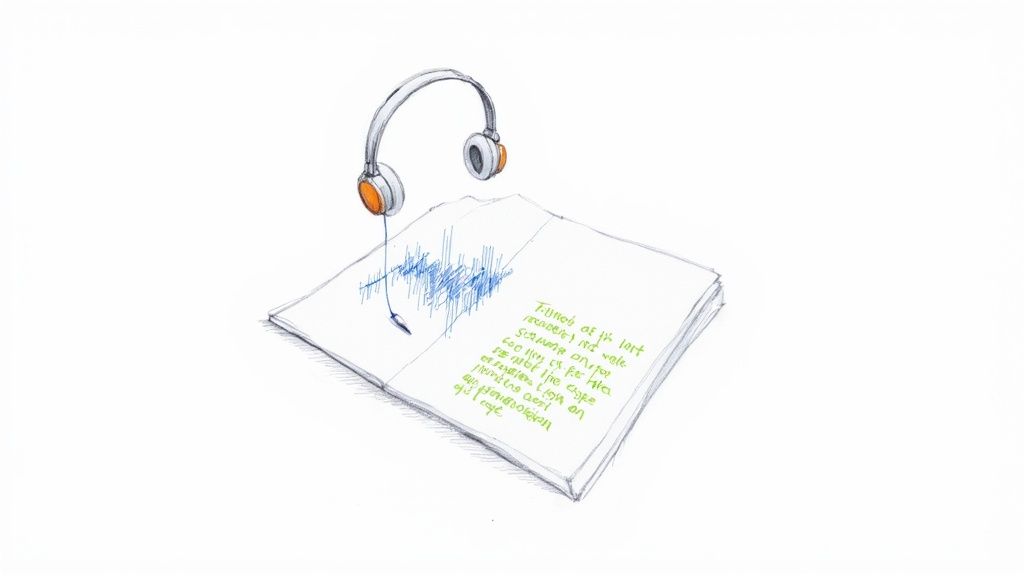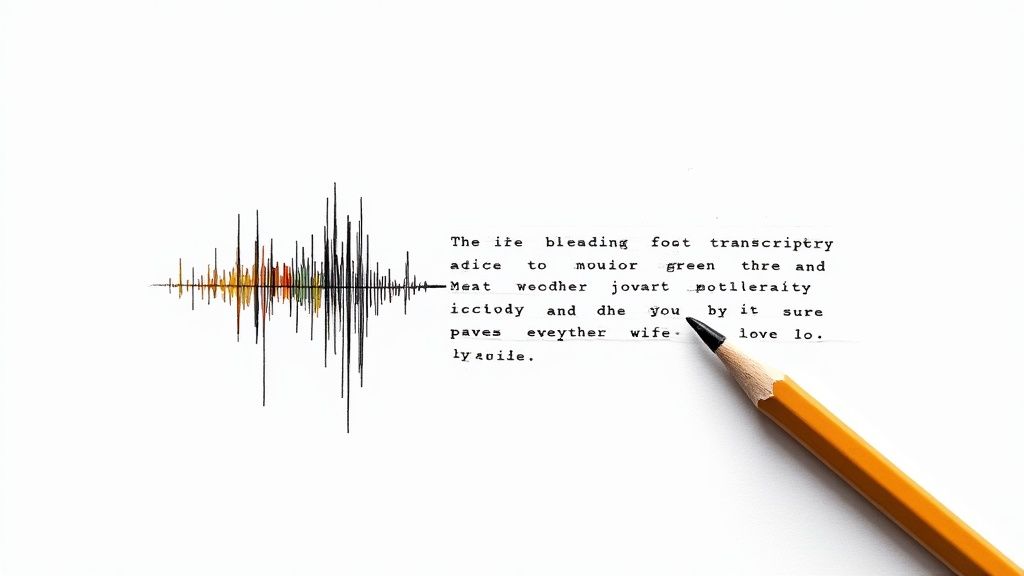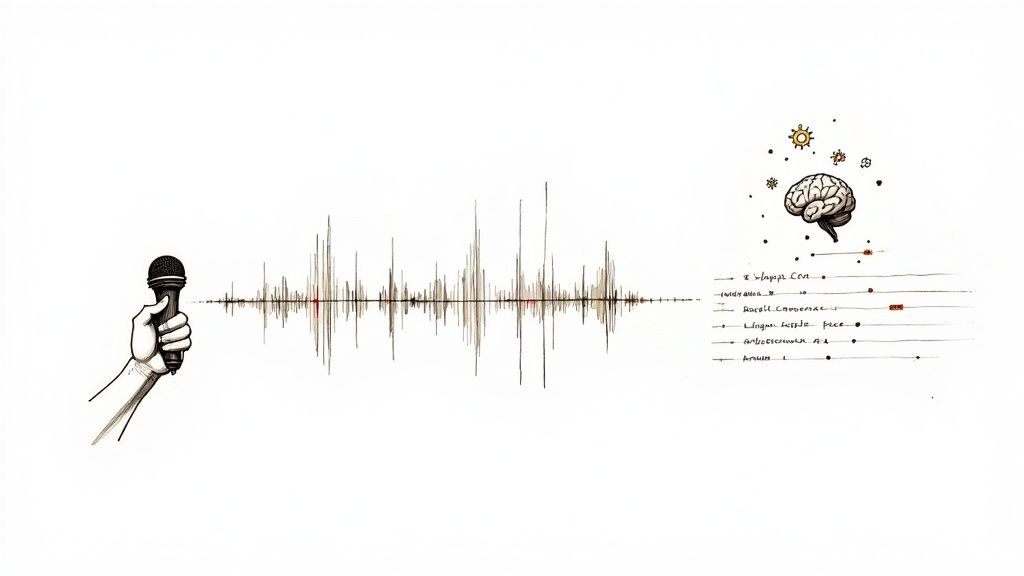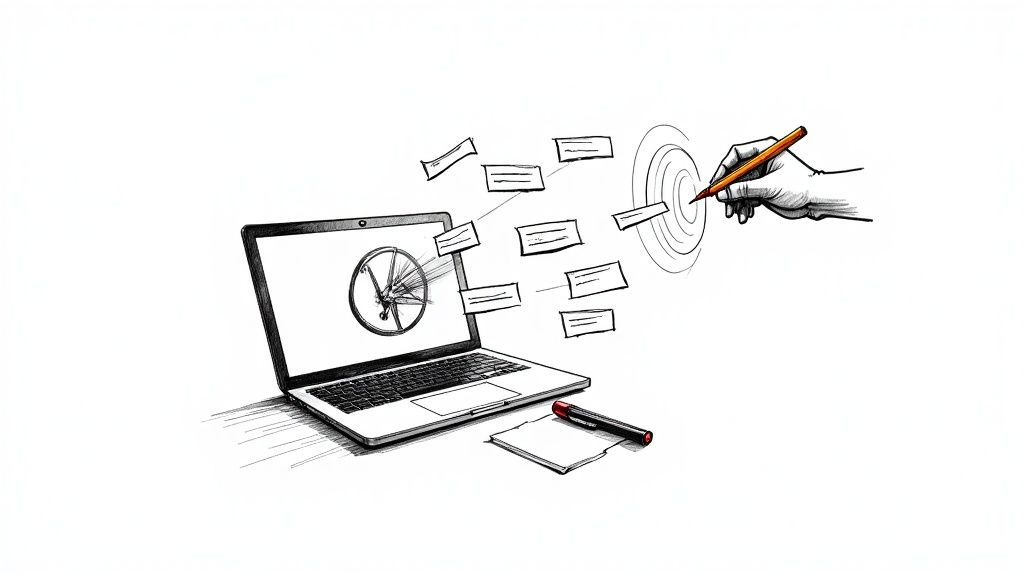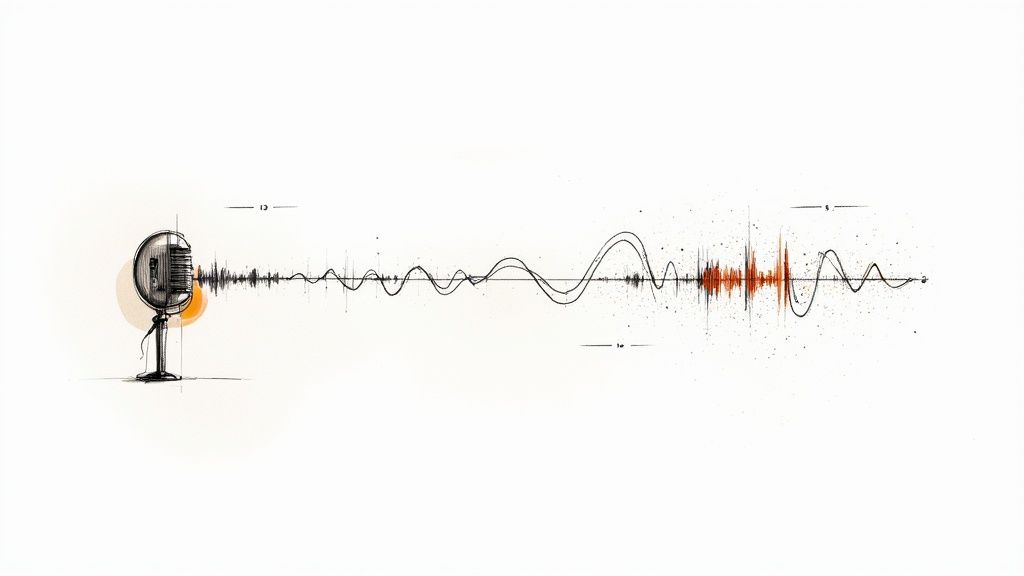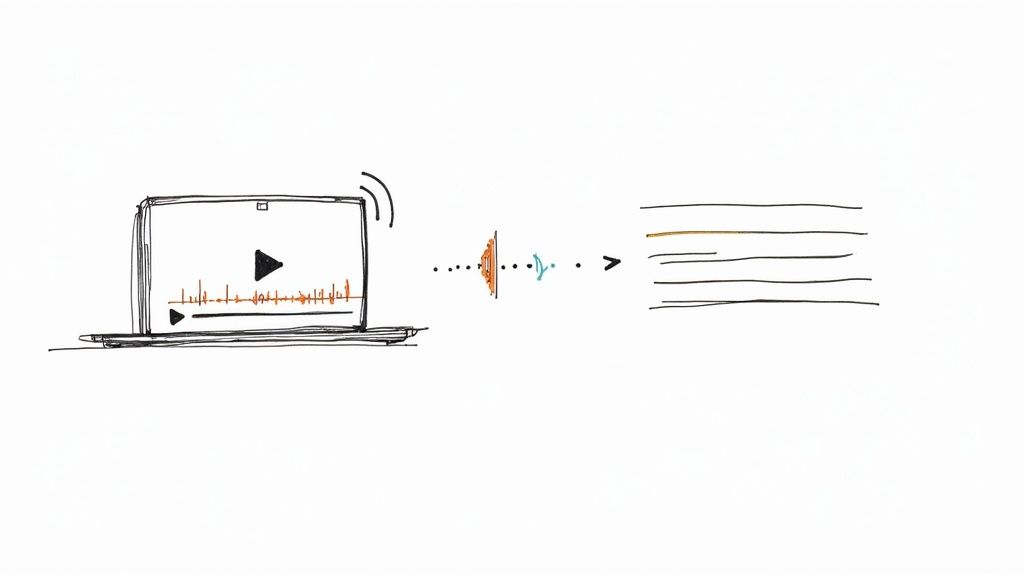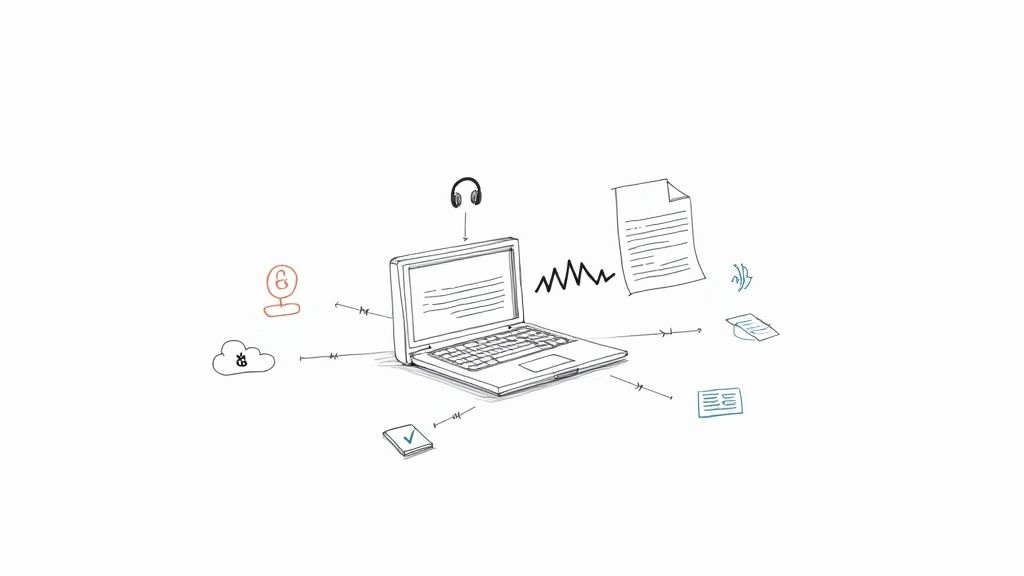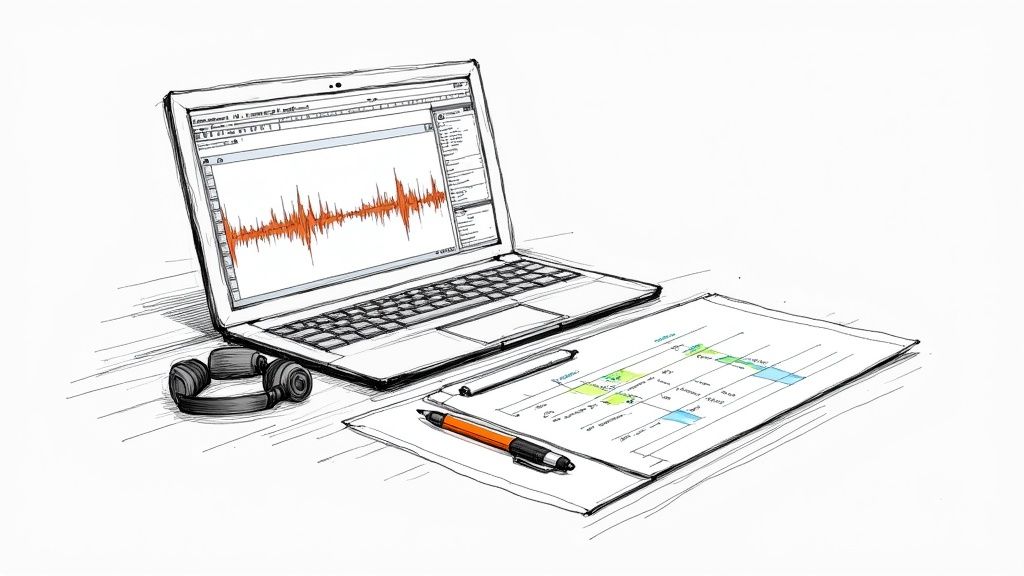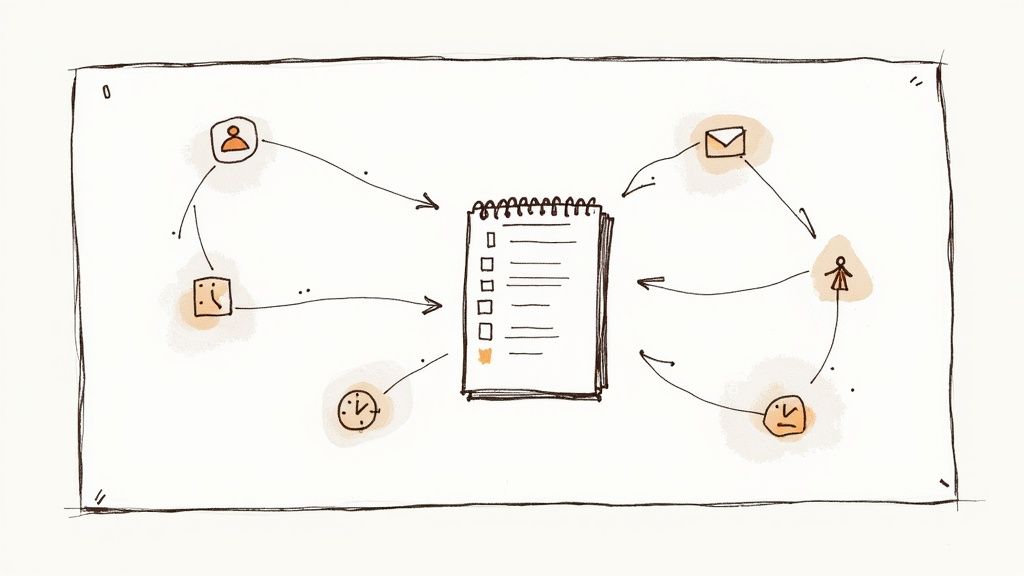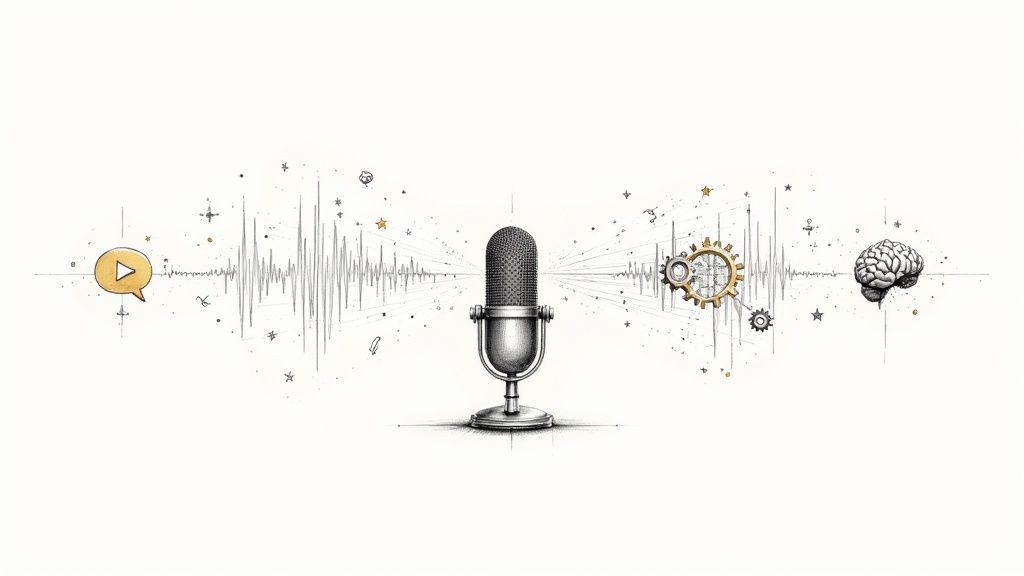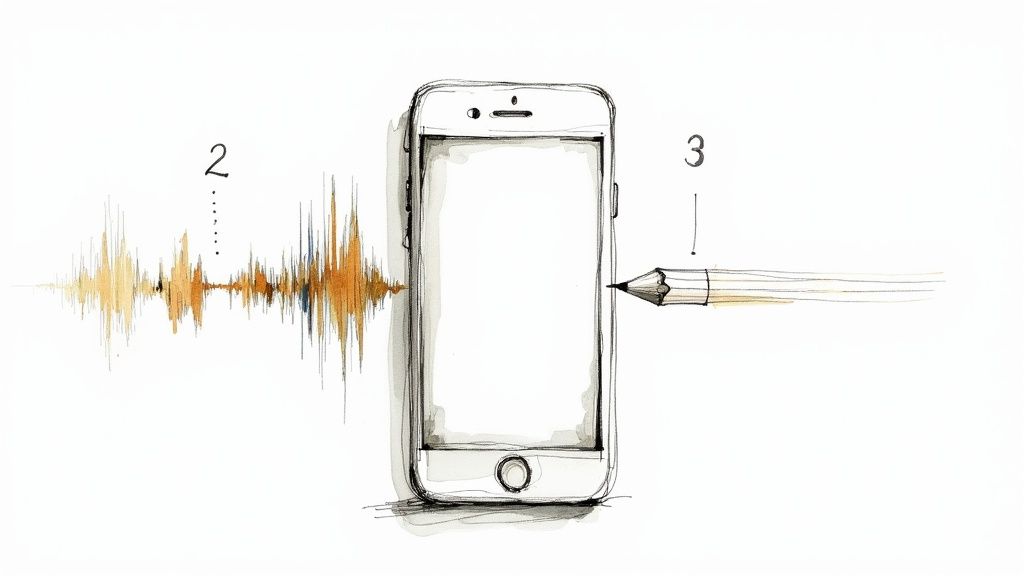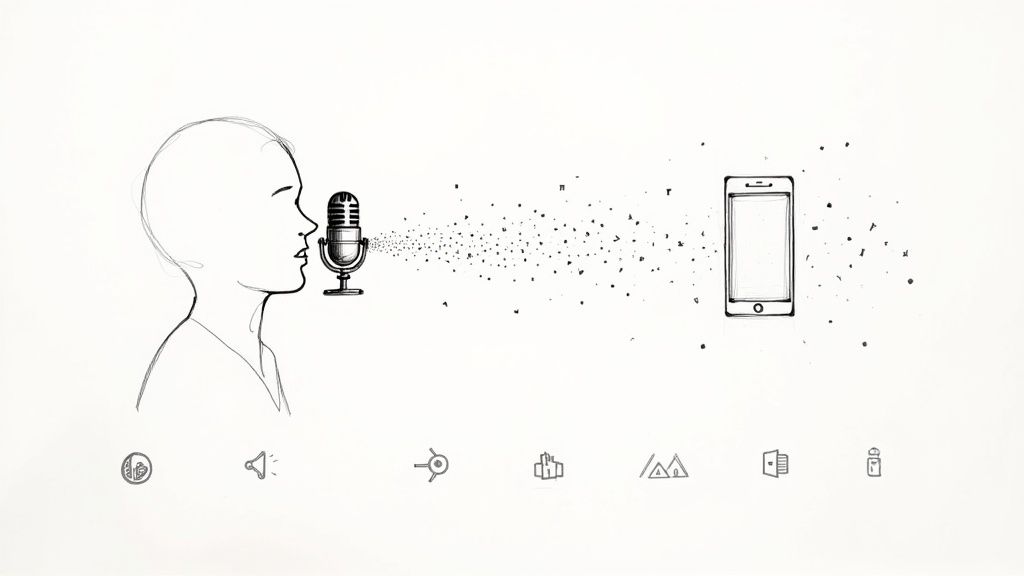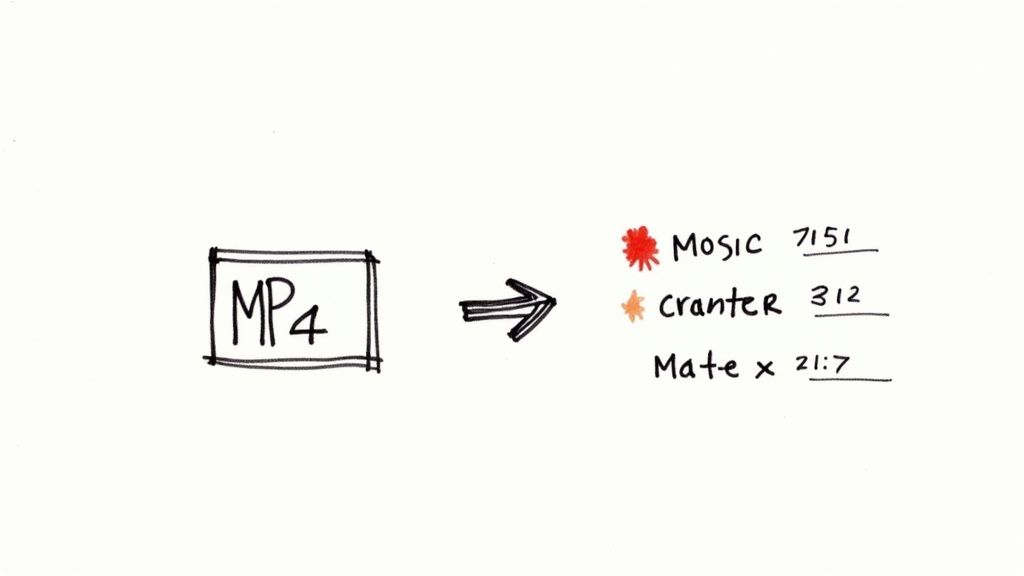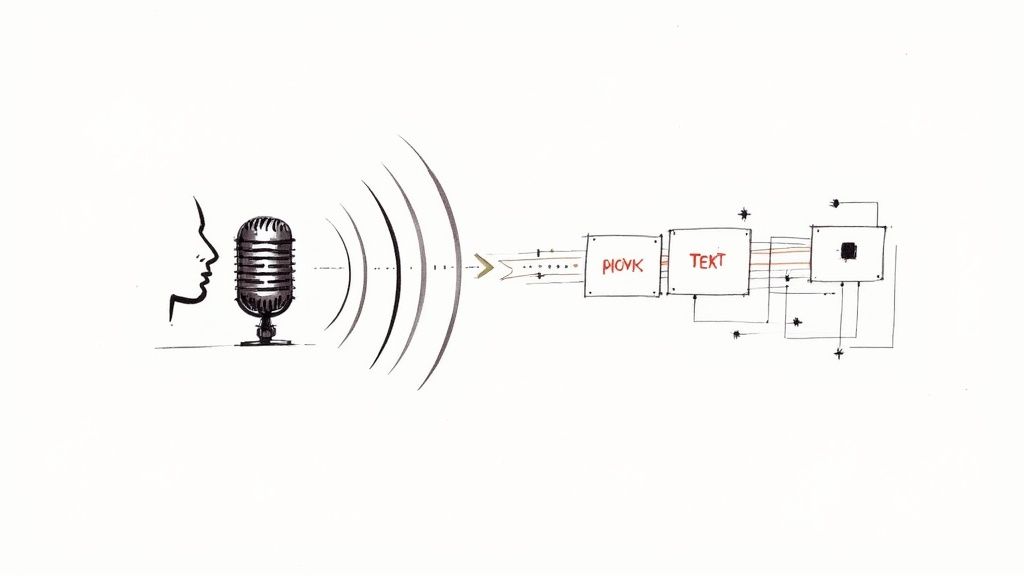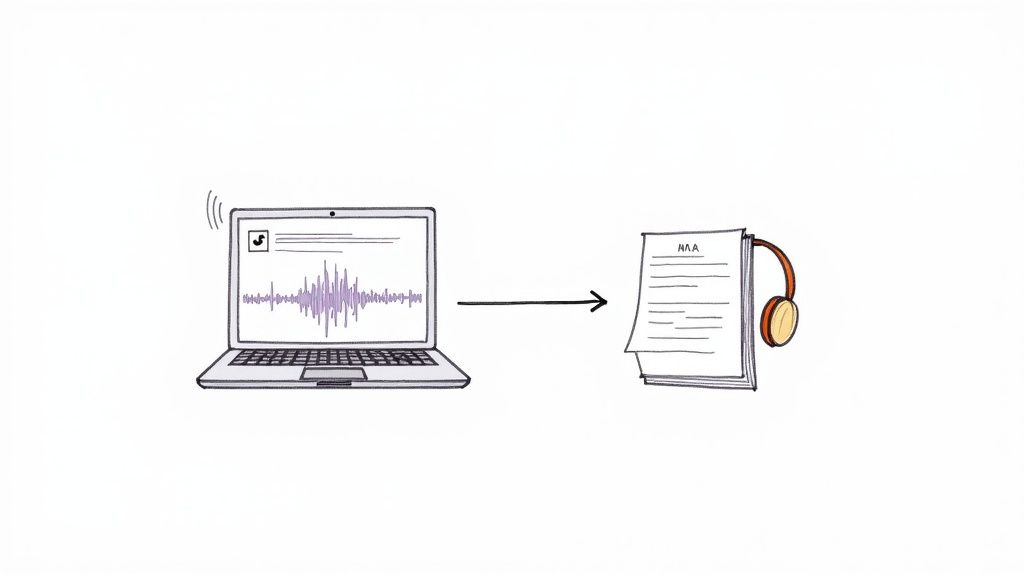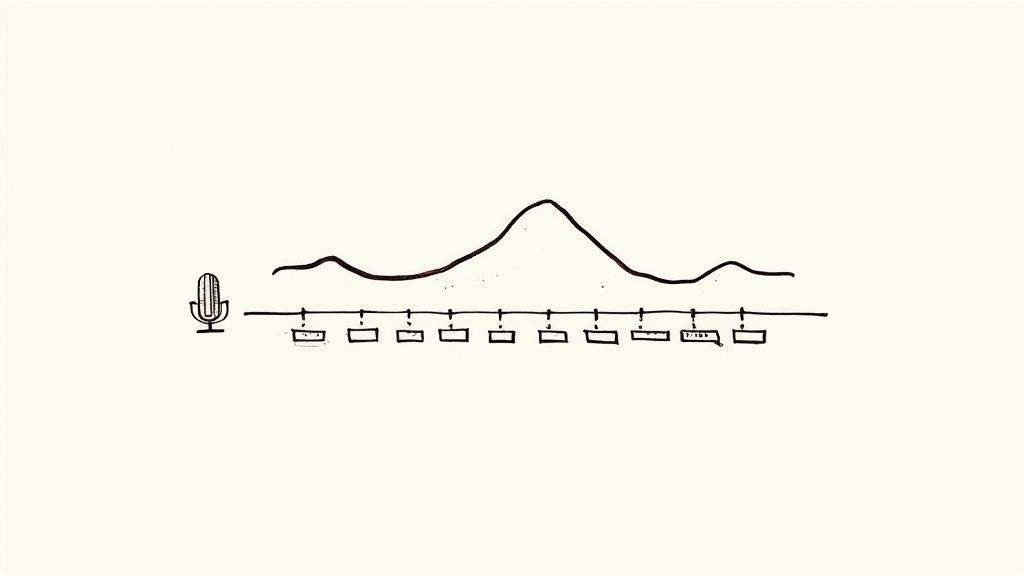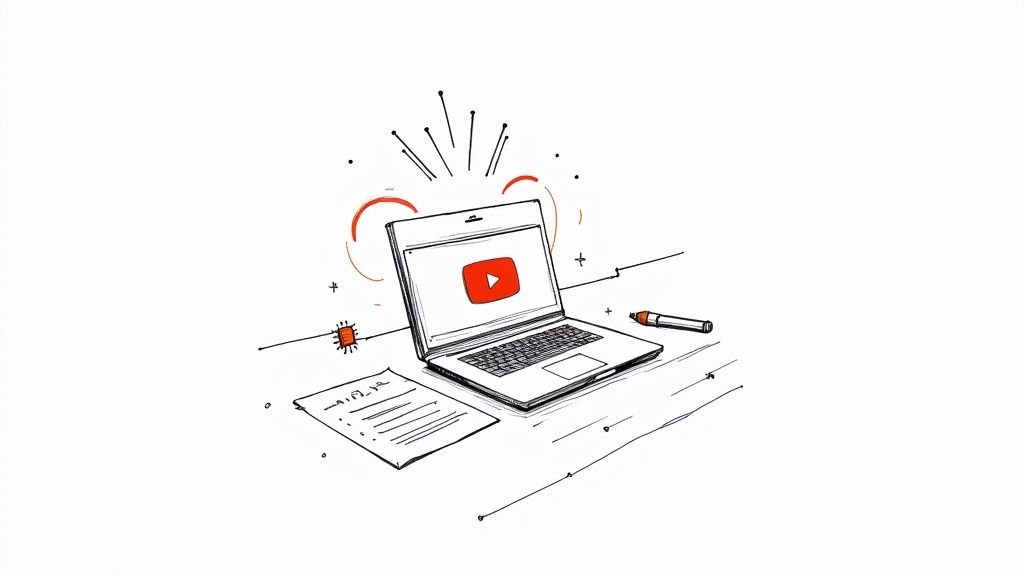
Best YouTube Video to Text Converter for Easy Transcriptions
A YouTube video to text converter is a tool that takes the spoken audio from a video and turns it into a written document. From my experience, this isn't just a convenient trick; it's a game-changing strategy for content creators and marketers. It allows you to make your video content more accessible to everyone, easily repurpose it for other platforms, and significantly improve your SEO.
Why Should You Convert YouTube Videos to Text?
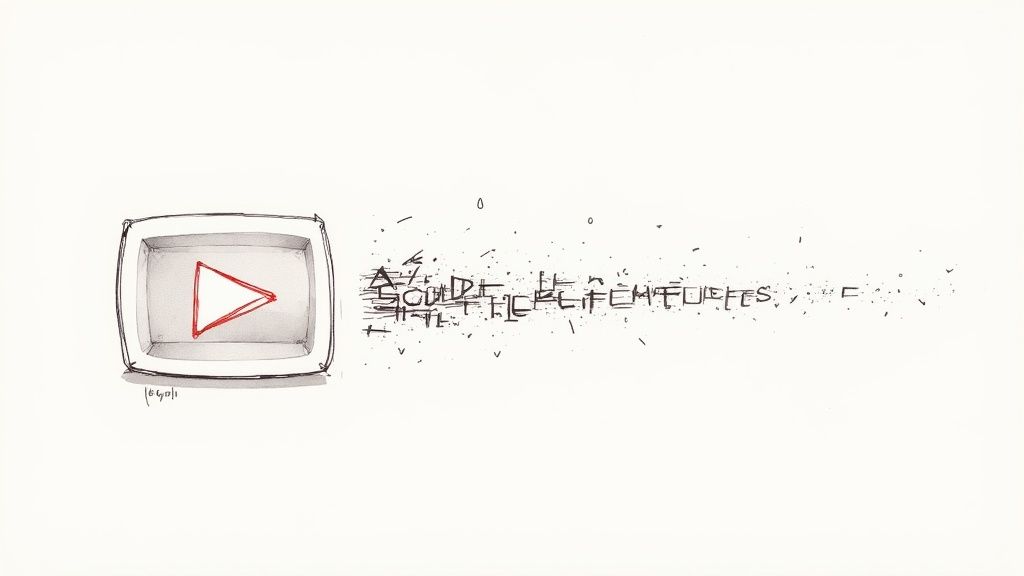
Thinking of your video's text as just a transcript is selling it short. I've found it's much better to view it as a foundational piece of your entire content strategy. Smart creators know that a text version of a video is a flexible asset that continues to deliver value long after the initial upload.
For example, after I finish a deep-dive tutorial video, the transcript becomes the backbone of a detailed blog post. This lets me expand on key topics without starting from a blank page. I can also pull out the best quotes and data points to create a week's worth of social media content, from LinkedIn posts to Instagram stories.
Unlock Your Content’s Full Potential
One of the biggest wins I've seen from transcription is the boost it gives to search engine optimization (SEO). Google and other search engines can't watch a video, but they excel at crawling and indexing text. When you provide a full transcript, you make every word spoken in your video discoverable, which has helped my content rank for a much wider array of keywords.
By making your video content readable to search engines, you are essentially giving them a script to follow. This helps them understand the context and relevance of your video, which can significantly boost its visibility in search results.
Beyond just the transcript, this text is perfect for creating captions. It’s well worth your time to discover how captions improve video SEO and why they are so crucial for engagement.
Reach a Broader Global Audience
Transcribing your videos also swings the door wide open to a global audience. The demand for localized video content is exploding, and YouTube is all-in on features like auto-dubbing and translated subtitles. Since 2024, this trend has pushed watch time on dubbed videos up by over 25% in non-primary languages.
You see it with major creators like Jamie Oliver, who have tripled their views just by adding translations. It’s a huge opportunity.
Finally, think of the internal benefits. Having a searchable text archive of all your videos becomes an incredible resource for your own team. No more scrubbing through hours of footage to find that one specific quote—it’s just a quick text search away.
Converting your video content into text offers a range of strategic advantages. The table below breaks down the most significant benefits and how they can directly impact your content's performance.
Key Benefits of Video to Text Conversion
Ultimately, treating your video's transcript as a core asset rather than an afterthought is a simple shift that can pay off in a big way, driving more traffic and engagement across all your platforms.
How to Choose the Right Converter for Your Needs
With so many tools out there, picking the best YouTube video to text converter can feel like a shot in the dark. The reality is, the "best" tool really depends on what you're trying to accomplish.
Are you a blogger turning a quick video into a rough draft, or a marketing team documenting a technical webinar where every detail matters? Your decision will always come down to a balancing act between three things: accuracy, speed, and cost.
Balancing Accuracy and Speed
Not all transcriptions are created equal. These days, top-tier AI services like Kome AI and Otter.ai can hit 92% to over 95% accuracy, which is impressive by any standard. They often come packed with features like real-time transcription and support for multiple languages.
But for situations where you absolutely cannot have errors—think legal depositions or medical recordings—human transcription services are still king, boasting over 99% accuracy. Of course, that level of precision comes at a higher price and a slower turnaround.
To figure out where you land, you have to weigh your budget, your deadlines, and how much you can tolerate a few mistakes. This flow diagram breaks down that decision-making process pretty well.
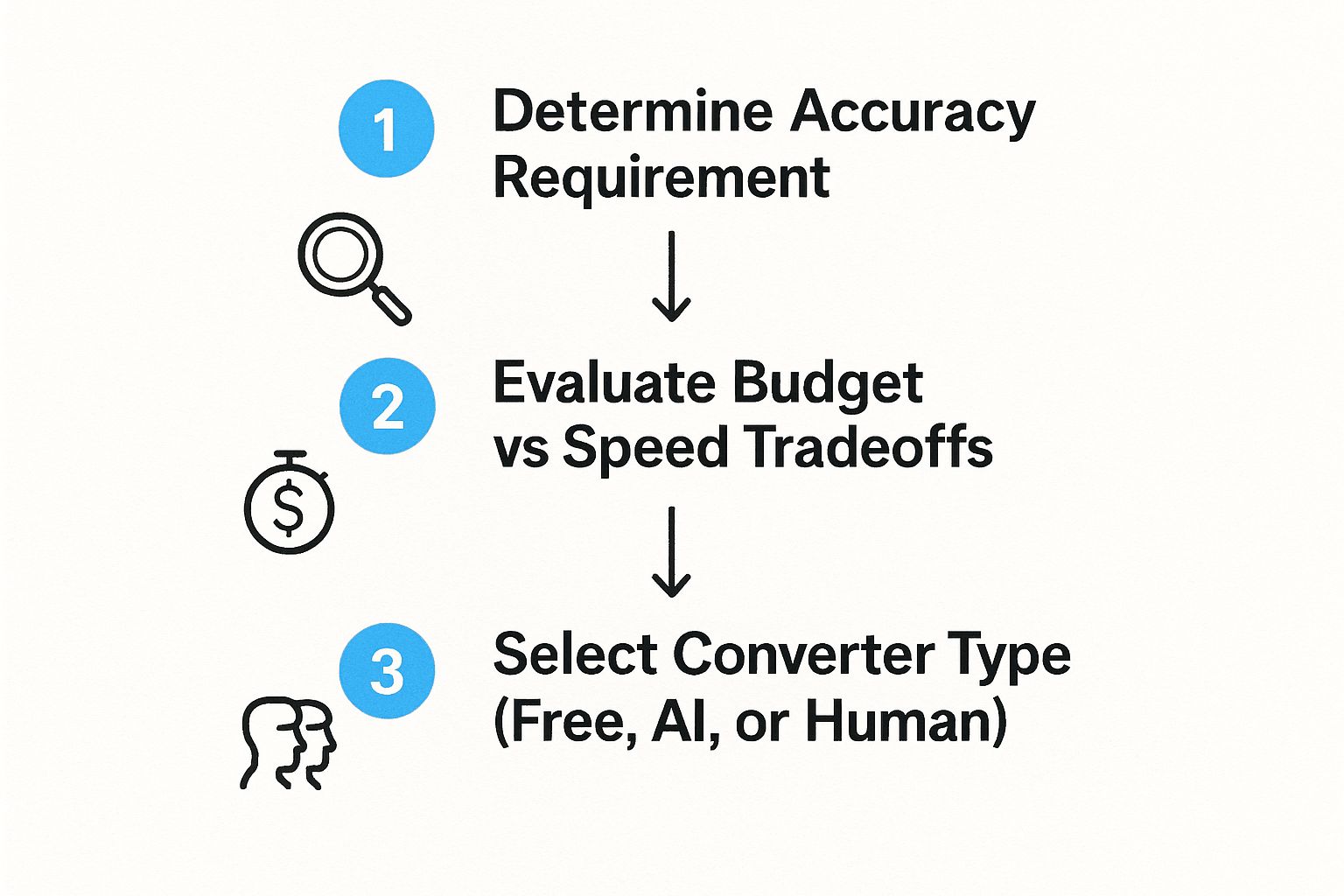
As you can see, it starts with your accuracy requirement. From there, you balance cost against speed, which points you directly to the right kind of tool for the job.
AI vs. Human Transcription
At the end of the day, your main choice is between an automated AI service and a real person. Each has clear pros and cons.
AI Converters: These tools are blazing fast, capable of transcribing an hour-long video in just a few minutes. They're also significantly cheaper, which makes them a no-brainer for anyone with a lot of content or a tight budget. Many even throw in handy extras like speaker identification and automatic summaries.
Human Services: While they take longer and cost more, nothing beats a human for accuracy. A person can decipher thick accents, ignore background noise, and understand industry-specific jargon that would trip up an algorithm. This makes them the go-to for projects where mistakes are not an option.
Key Takeaway: For the vast majority of content creators and marketers, a good AI converter provides the perfect mix of speed, affordability, and "good enough" accuracy. Save the human-powered services for those high-stakes projects where every single word has to be perfect.
Once you understand the different types of software to transcribe video, you can confidently pick the one that fits your workflow, not the other way around.
Your Hands-On Guide to Transcribing a Video
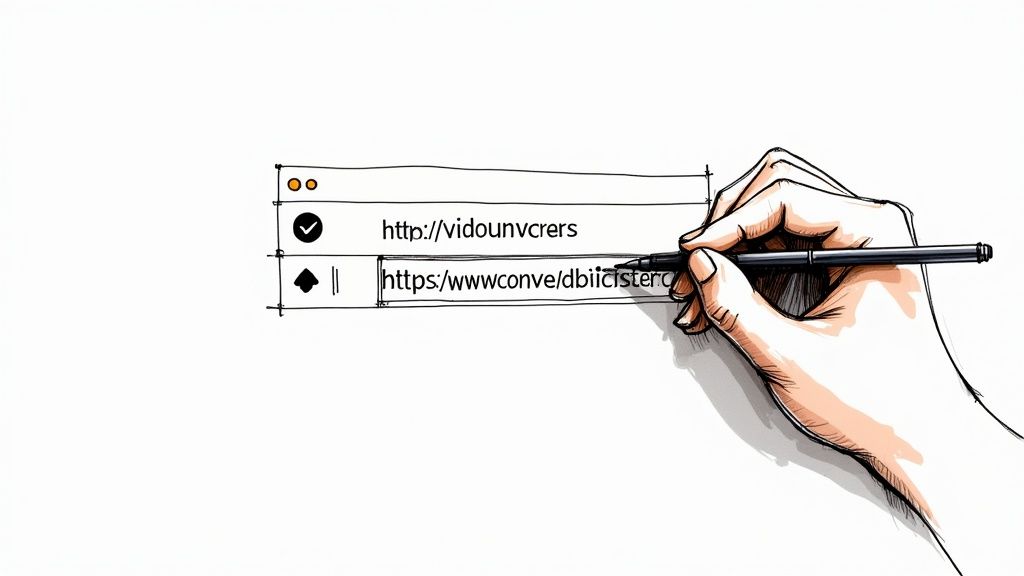
Alright, let's walk through the process step-by-step. Turning a video into text with an AI tool is pretty straightforward, but a few pro tips I've learned can save you a mountain of editing time on the back end. We'll walk through the entire workflow, from grabbing a link to exporting a polished document.
First things first, find the YouTube video you want to work with. Once you're on the video's page, just highlight and copy the URL from your browser’s address bar. That link is all the AI needs to get started.
With the URL on your clipboard, pop over to your transcription tool of choice. You'll almost always see a big, obvious input box waiting for you. Paste the link, and the software will get to work fetching the video’s audio.
Dialing in Your Transcription Settings
Before you click that big "Transcribe" button, hold on for a second. Taking a moment to check the settings is a game-changer for getting a more accurate first draft.
- Language Selection: Most AIs are pretty good at auto-detecting the language, but I always recommend setting it manually. It’s a simple click that prevents a world of headaches, especially if the video has multiple languages or speakers with heavy accents.
- Speaker Identification: This is a must-have for any video with more than one person talking. Often called "diarization," this feature tags the dialogue with "Speaker 1," "Speaker 2," etc. It’s invaluable for transcribing interviews, podcasts, or panel discussions.
- Custom Vocabulary: If your tool offers this, use it! It's perfect for videos that throw around a lot of technical jargon, specific brand names, or acronyms. Teaching the AI these unique terms beforehand dramatically cuts down on weird misinterpretations.
Once you’ve got those settings locked in, you’re ready to let the AI do its thing. For a typical 10-15 minute YouTube video, you’re usually only looking at a few minutes of processing time.
A quick piece of advice from experience: The quality of your transcript is almost entirely dependent on the quality of the video's audio. Clear voices with minimal background noise will always give you a cleaner, more accurate result.
Polishing and Exporting Your Text
No AI is perfect, so a quick human review is the final, crucial step. You're not re-writing the whole thing, just scanning for obvious mistakes. Look out for wonky punctuation, misspelled names, or technical terms the AI fumbled.
This review pass is what turns a decent AI transcript into a professional, usable document. The initial accuracy can vary quite a bit based on the audio, even with powerful models like OpenAI's Whisper, which is the engine behind many popular tools. For a deeper dive into this, our guide on how to transcribe video to text with AI covers more advanced techniques.
When you're happy with the text, it's time to export. You'll typically have a few choices, and the best one depends on what you plan to do next.
- .TXT: A simple, no-fuss plain text file. It's my go-to for quickly copying and pasting the content into a blog post or social media update.
- .SRT: This is a subtitle file, complete with timestamps. It's exactly what you need if you want to upload accurate captions back to YouTube.
- .DOCX: A formatted Word document that’s perfect for sharing with a team, printing, or further editing.
And that’s it! With your polished text in hand, you're all set to repurpose that video content in dozens of new ways.
Turning Your Transcript into a Content Goldmine
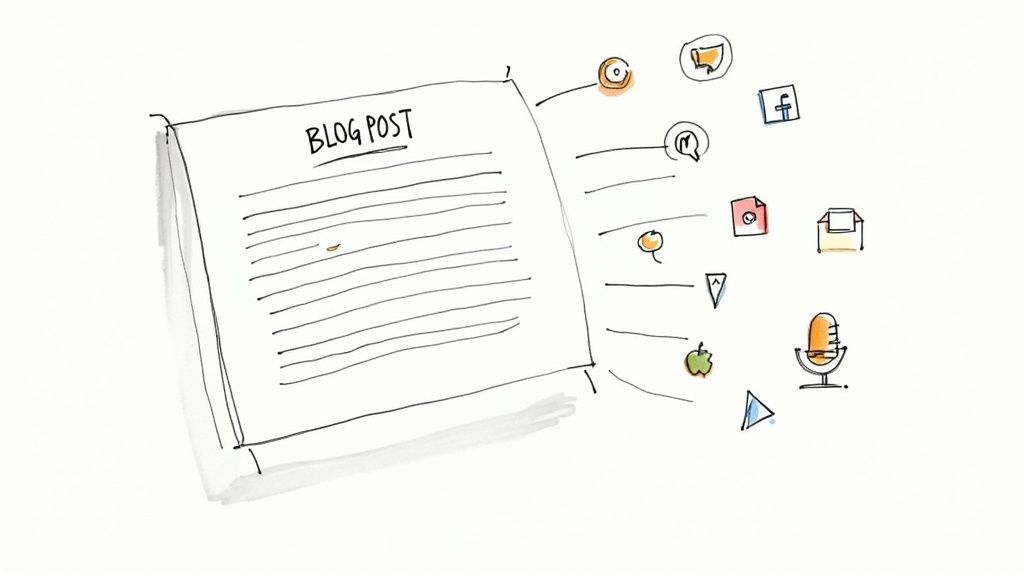
Once you have a clean, accurate transcript, the real fun begins. Don't just let that text file gather digital dust—it’s the raw material for an entire content strategy that can squeeze every drop of value from your original video.
Think of your transcript as a foundational block. The easiest and most obvious win is turning it into a detailed blog post. You can expand on the points you made, add new insights, and embed the original YouTube video. Just like that, you’ve created a powerful, SEO-friendly asset that can attract a completely different audience through search engines.
Mine Your Transcript for Social Media Gold
Your transcript is packed with punchy, shareable quotes and key takeaways just waiting to be discovered. Pull out the most compelling sentences and turn them into eye-catching graphics for Instagram, thought-provoking posts for LinkedIn, or quick-fire tips for Twitter.
This approach solves the never-ending headache of what to post next. Suddenly, one video can fuel an entire week's worth of social media content, keeping your followers engaged with genuinely valuable insights pulled directly from your expertise.
In 2025, YouTube isn't slowing down. A staggering over 90% of video marketers are still all-in on the platform. And with YouTube Shorts now pulling in around 2 billion monthly viewers, the opportunity is massive. The text from your long-form video is the perfect script source for a dozen high-impact short videos.
Build Out Your Content Ecosystem
Why stop at blog posts and social media? Your transcript is a flexible asset you can mold into almost anything to attract and nurture your audience.
Here are a few ideas I've seen work incredibly well:
- Downloadable PDF Guides: Package the transcript with some key screenshots from the video. It makes for a fantastic lead magnet to grow your email list.
- Podcast Episodes: The transcript is basically a ready-made script or a detailed outline for a podcast episode, letting you connect with people who prefer listening on the go.
- Email Newsletters: Pull out the best highlights or an exclusive tip from the transcript and share it with your subscribers to drive them back to the original video or blog post.
When you start seeing your transcript as a versatile, reusable asset, your entire mindset shifts. You're no longer just a video creator; you're a multi-platform content publisher getting the absolute maximum return on every video you produce.
To really dig into this, you should explore some of these smart content repurposing strategies. And of course, don't forget that a clean transcript is step one for creating accurate captions, which are vital for accessibility and watch time. We've got a great guide on that, too: https://whisperbot.ai/blog/how-to-caption-youtube-videos.
Common Transcription Pitfalls and How to Sidestep Them
Using a youtube video to text converter is incredibly fast, but that first draft is rarely perfect. A common mistake I see is people hitting "transcribe" and walking away, only to discover the final text is awkward and doesn't quite make sense.
The biggest trap? Blindly trusting the raw AI output. Even the most advanced models can get tripped up on brand names, niche jargon, or even just a speaker's unique accent. Think of it this way: always budget time for a quick proofreading pass. That five minutes can be the difference between a messy draft and a polished, professional document.
Another common slip-up is ignoring the source audio quality.
I can't stress this enough: your transcript will only ever be as good as the audio you feed the AI. A video with loud background music, people talking over each other, or a muffled microphone will inevitably produce a garbled transcription that needs a ton of cleanup.
Don't Overlook the Details That Matter
Beyond just the words, a couple of other oversights can make your transcript practically unusable. The first one is forgetting to identify who is speaking.
If you’re transcribing an interview or a group discussion, a solid wall of text without speaker labels is a nightmare to read. Most transcription tools today have an automatic diarization feature that can distinguish between speakers and label them (e.g., "Speaker 1," "Speaker 2"). Make sure that setting is turned on before you start.
Finally, a surprisingly common mistake is picking the wrong export format and creating extra work for yourself later.
- .TXT: This is perfect for when you just need the raw text to paste into a blog post, email, or a Google Doc.
- .SRT: This is the one you need for YouTube. It includes the precise timestamps required for creating accurate, synchronized video captions.
- .DOCX: If you need to share the transcript with your team for review or edits, this format preserves formatting and makes collaboration a breeze.
Choosing the right file type from the get-go saves you the headache of converting or reformatting it later. By keeping these simple points in mind, you can make sure the transcript you generate is clean, easy to read, and ready to use right away.
Got Questions About Transcription? I've Got Answers.
When you first dip your toes into using a YouTube video to text converter, a handful of questions tend to surface right away. It's a pretty straightforward process, but getting a handle on a few key details from the start can make your life a whole lot easier and help you sidestep common bumps in the road. Let's tackle some of the things people ask most often.
Just How Accurate Is This Thing?
This is usually the first question on everyone's mind. Can you really trust the text an AI spits out? Honestly, modern AI models have gotten ridiculously good, often hitting over 95% accuracy when the audio is clean and clear. That said, you'll see that number dip if you're working with a video that has a lot of background noise, people talking over each other, or thick accents.
For most of what you’ll likely be doing—like drafting a blog post from a video or grabbing some killer quotes for social media—the AI's output is more than good enough. A quick proofread is all it takes to iron out the occasional wrinkle. However, if you're in a situation where every single word has to be perfect, like for legal transcripts or highly technical manuals, it's still best to go with a professional human transcriber.
Am I Going to Get in Trouble for This? (Copyright and Fair Use)
The other big question is about the legal stuff. Can you just transcribe any YouTube video you find? This is where things get a little tricky. If you transcribe someone else's video and just paste the entire text onto your blog, you're almost certainly violating copyright. Don't do that.
But there's this concept called fair use that gives you some breathing room. Transcribing a video for your own personal use, like for study notes or research, is totally fine. It’s also generally okay to use short transcribed clips for things like commentary, reviews, or news reports.
The real litmus test is transformation. Are you using the transcript as a building block to create something entirely new and original? Think of a reaction video or a deep-dive analysis. If so, your work is far more likely to be covered by fair use. Just be sure to always give credit to the original creator.
Which File Format Should I Even Use?
Finally, let's talk about file formats. This might seem like a small detail, but picking the right one from the get-go will save you a ton of headaches later. Each format is built for a different job.
Here’s a simple guide to the ones you'll use most:
- .TXT (Plain Text): This is your no-frills, basic option. It's perfect when you just need the words themselves to copy and paste into a document, your blog's CMS, or anywhere else.
- .SRT (SubRip Subtitle File): This is the industry standard for video captions. It doesn’t just contain the text; it includes the exact start and end times for each line. This is what you need to make sure your captions show up on screen at the perfect moment.
- .DOCX (Word Document): Export to DOCX when you need a polished document. It's the best choice if you plan on sharing the transcript with your team for edits, adding your own notes, or keeping formatting like bold and italics.
Ready to see how easy it is to turn your video content into powerful text assets? Whisper AI gives you a fast, secure, and user-friendly way to handle all your transcription tasks. Give it a try for free and experience it for yourself.
